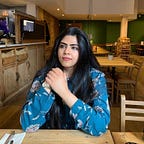FMP/ Migrant Integration — 08. Emplacing Action in the Neighbourhood
To recap briefly → after analysing the different stories of immigration of four migrants to the UK, the need for implementing social design has been established. Social design provides an opportunity for developing community well-being by activating social activity for people, in this case, between migrants and hosts. This serves to facilitate integration of personal identities of migrants with the society and achieving orientation with the cultural master narrative.
Following the identification of a compelling research problem and determining a definite research goal for it, the project is headed towards the ideation and concept generation phase. However, before that, it is important to comprehend the environment in the real world where this social action would be contained.
Ending up in the Neighbourhood
Since the objective of ‘fostering community for belongingness’ underpins the formulated research goal together with ‘building intercultural cohesion’, the space of neighbourhood is deduced as a potent touchpoint for meeting these targets. This is because it allows the most proximal impact in daily lives. In the research of community psychology, the neighbourhood environment has been a focus of study (Sarason, 1973) as it sets the stage for interactions to take place between people, instilling a sense of community (Sarason, 1974). The concept of sense of community, elaborated by McMillan and Chavis (1986), is a multidimensional construct influencing fulfilment of needs and shared emotional connection to neighbourhood.
In this project, it is all the more important to attend to the issue of building social cohesion in neighbourhoods of superdiverse cities such as Britain’s. Diversity is alleged to reduce trust in neighbours and hence civic participation, a phenomenon which Putnam (2007) refers to as ‘hunkering down’. Thus, to mitigate the negative effects of diversity, out-group contact should be encouraged.
Moreover, owing to restrictions posed by the pandemic, not much was being feasible to experiment in the public. So, trialing ideas within the neighbourhood was yet a better approach to gain evaluation from people. Where in the neighbourhood, is yet to be decided.
Also, by selecting the neighbourhood as a premise for conducting my experiment, I could involve the Iraqi family who had contributed their insights earlier to test if they were being benefitted by the solution. In this approach, I prepared myself to pursue longitudinal research design for this project in which repeated observations of the same variable (people) are performed to detect any changes that could occur over a period of time. I recollected the reference given by Eva in the tutorial held few weeks ago, where a set of parents separated by their child due to working patterns make use of a bespoke machine to share locations playfully. The project can be seen here: https://figshare.com/articles/journal_contribution/Ritual_Machine_V_Where_are_You_/4746958
In College: Crazy 8s with the Crazy 8
As I had been conducting my project based from Edinburgh, I couldn’t frequently attend feedback sessions hosted in person in college. But, at this crucially complex stage in the project, I decided to travel down to London for discussing my progress with tutors and getting feedback from classmates. It was an opportune moment as Mor, our associate professor, was holding workshops of crazy 8’s for all the classmates. The agenda was to generate ideas for others’ projects.
In the workshop, I participated along with 7 other of my classmates. The first round that took place was about my project and developing ideas for it collectively. After presenting briefly the progress of my project within 3 minutes, the 8 people (Mor also helped) started listing down ideas one by one in the count of 8 minutes. It meant that, 8 x 8 = 64 ideas generated, excluding mine. There was a range of interesting ones being created: exchanging messages recorded on cassettes with neighbours; recipe book table filled with recipes listed from different cuisines; gifting portraitures; installing proximity-sensing plants; decorating home together; and so on.
The following images show worksheets of some of the collaborators, each divided into 8 squares.
Next, during the individual tutorial with Mor, I was suggested to look up a project ‘MetaboliCity’ which was about empowering people to grow food together communally. It catered to the goal of achieving environmental sustainability along-with community-building for people living in urban cities. The project can be seen here: https://loop.ph/portfolio/metabolicity/
She also encouraged me to pursue developing a design outcome unbound by its medium, it could be either digital or physical or even be ‘phygital’.
Feedback
Tutorial sessions with John and Tiffany; Alaistair and Wan; and a group of 3 classmates were also held. Each of them proved to be immensely helpful in directing my future actions.
1. On the whole, I was being advised to start rapid experimentation to test my ideas by making low-fidelity prototypes.
2. They guided me that choosing different locations for installing the apparatus, I could explore three levels of intimacy in neighbourhood. Alaistair recommended to read about Richard Wentworth’s practise of curating quotidian examples of human interaction; in “parallel worlds of engagement with the provisional acts of invention and intervention” (Henry, 2007).
3. Thirdly, it was proposed unanimously that I should look for setting up the social activity in neighbourhood based on common or shared interests.
Bibliography
Demireva, N. and Heath, A. (2014) ‘Diversity and the Civic Spirit in British Neighbourhoods: An Investigation with MCDS and EMBES 2010 Data’, Sociology, 48(4), pp. 643–662. doi:10.1177/0038038513516695.
Gary G Aguiar (2002) Bowling Alone: The Collapse and Revival of American Community, The Social Science Journal, 39:3, 489–490, DOI: 10.1016/S0362–3319(02)00190–8
‘MetaboliCity’ (2008). Available at: https://loop.ph/portfolio/metabolicity/.
‘Ritual Machine V: Where are You?’ (2019). Available at: https://figshare.com/articles/journal_contribution/Ritual_Machine_V_Where_are_You_/4746958.
Sarason, I.G. (1973) ‘The evolution of community psychology’, American Journal of Community Psychology, 1(1), pp. 91–97. doi:10.1007/BF00881250.
Wessendorf, S. (2019) ‘Migrant belonging, social location and the neighbourhood: Recent migrants in East London and Birmingham’, Urban Studies, 56(1), pp. 131–146. doi:10.1177/0042098017730300.
